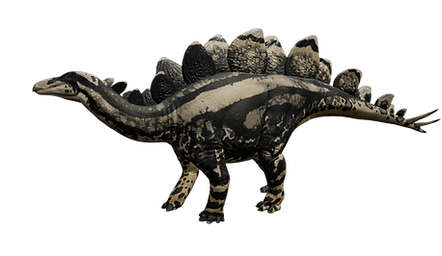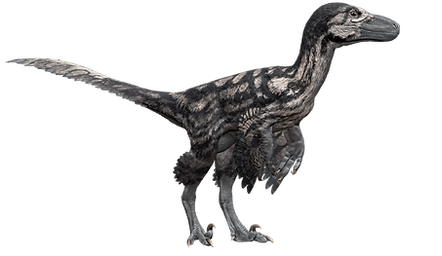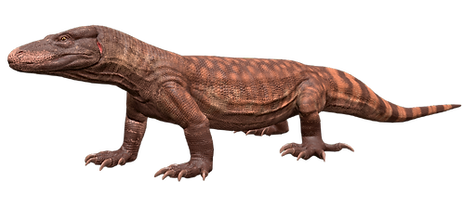PATH OF TITANS SKIN GUIDE
PROJECT GENESIS
This guide will help you create realistic and engaging skins. While we do not enforce these to be used, do pay attention to the section which does cover up the kinds of skins which break PoT Rule 2. You can check that section here.

THE BASICS OF A REALISTIC SKIN
COUNTERSHADING AND SIZE
While we don’t know what many dinosaurs actually looked like in terms of colours, we can get a rough idea from looking at modern-day animals and basing our colour choices off that.
The first thing you will notice is something called counter shading. This is where the underside of the animal is the lightest colour, while the top is the darkest.
Small to medium animals often will show this, as it helps with blending in with their backgrounds. However, with particularly large animals, such as the largest theropods or sauropods, you could propose a skin with no countershading. This is because the sheer mass of the animal is a deterrent good enough to deal with potential threats, with no need of it to be hidden or hard to find.


Examples of countershading in Deinonychus and Iguanodon.
SEXUAL DIMORPHISM & BRIGHTNESS
Sexual dimorphism is a constant difference in shape, size or colours between males and females of the same species. Pronounced examples of these include birds and some species of fish. Most mammals show few sexual dimorphic traits relating to size or colour. Most reptiles show dimorphism in some way as well. Due to this, it is logical to assume that many dinosaurs exhibited clear differences between both sexes.
In our profiles, sexual dimorphism will be explicited pointing out the physical differences. If there is no sexual dimorphism, then the sexes are what is called monomorphic, and will be differentiated due to their behaviours.
But how do we convey this in our skins creatively? We can use something that can be called "extended sexual dimorphism". In these cases, the colourful crests or bright shades (for example in male birds), will extend all across the body, and not just the head.


Examples of sexual dimorphism in a Parasaurolophus model.
Note the extended sexual dimorphism in the male.


Examples of monomorphism in Pachycephalosaurus.
In these cases, behaviour will often set the sexes apart.
COLOURATION AND CONTRAST
Colouration is the general appearance of an organism. Depending on the competition and stresses which a species has to overcome, different strategies are developed along an evolutionary line. The following are examples of different kinds of colourations, which reflect a particular lifestyle.
DISRUPTIVE COLOURATION
Disruptive colouration is most often found in predators and smaller prey, but it could be used in any animal which benefits from behind hidden, (such as animals that live in places with a lot of vegetation). This helps break the silhouette of an animal, and confuses a potential predator, as it will not know when the prey starts and when it ends.
You can achieve this kind of colouration by using muddy browns, greys, faint reds and even greens. Avoid high-contrasting combinations and bright colours to better camouflage with your surroundings. Low contrasting stripes and spots are also common in animals with this kind of colouration.


Examples of disruptive colouration in Alioramus and Psittacosaurus.


Examples of non-disruptive colouration in Alioramus and Psittacosaurus.
APOSEMATIC COLOURATION
Aposematism is a kind of "honest advertising" by an animal to potential predators that it is not worth attacking or eating. This manifests itself in all sorts of different ways, but we will be looking at its colours and patterns in particular. These signs benefit the prey item due to it being less likely of being attacked, and the predator due to it avoiding a potentially dangerous engagement.
Aposematism is most common in some amphibians, reptiles and insects. It can be expressed through very bright and contrasting colours, with striking shapes. This includes things like eye shapes, stripes of alternating colour and bright spots in the body of the creature.
This kind of colouration is most often shown by poisonous or venomous animals and particularly aggressive species. Instead of blending in, they advertise to the whole world that they're not something to be messed with.


Examples of aposematic colouration in Camptosaurus and Stegosaurus. Notice the striking pattern.
MUTATIONS OF ALL SHADES
PIGMENT MUTATIONS
Say you want to play with unusual colourations without being unrealistic. Here's how you can do just that. The following are three common mutations found in nature all across the board of the tree of life:
Albinism - a complete lack of pigment (white all over).
Leucism - a partial loss of pigmentation (partially white).
Melanism - too much pigment (very dark colours).
There's also erythrism, which is excess of red pigmentation, and axanthism, which is absence of red pigmentation. The mutations are many, and you can research more on this if you like!
Reptiles in particular may showcase one or more of these mutations. This is most obvious in "morphs", which are often seen in reptiles common in the pet trade: corn snakes and ball pythons are some of the species with the most amount of morphs.
-
Albinism is often associated with conditions such as blindness or deafness. Again, it is your choice what to do, and you can play a perfectly healthy albino dinosaur.
These kinds of mutations can be the reason why you are rejected as a mate, depending on profile or on the player's preference. Keep this in mind when courting!


Examples of albinism (left) and leucism (right) in Triceratops.
Note that leucistic animals can still show dark colours or patterns.
Albinos will instead have red and pink where leucistics will be dark (such as eyes or soft tissue).


Examples of melanism (left) and albinism (right) in Maip. Melanism is often less harmful to the animal.


Examples of axanthism (left) in Latenivenatrix and erythrism (right) in Megalania.
UNREALISTIC SKINS
SKIN CREATION "DO-NOT's"
But what is an unrealistic skin?
You may be able to find colour combinations which are striking, odd-looking and also just plain silly. Without considering the profile (which you must make an effort to follow when making a skin, if there is an indication of what colours a species usually sports), there are a few key points which you must keep in mind when making a skin.
-
Avoid bright colours and patterns with no justification in profile or lifestyle.
-
Neon colours must be avoided.
-
Patterns which are unnatural-looking (such as a perfect heart shape or skull shape, for example) should be avoided.


Examples of poorly realistic skins. Neon and bright colours in the
Styracosaurus (left) and unnatural patterns in the Ceratosaurus (right).